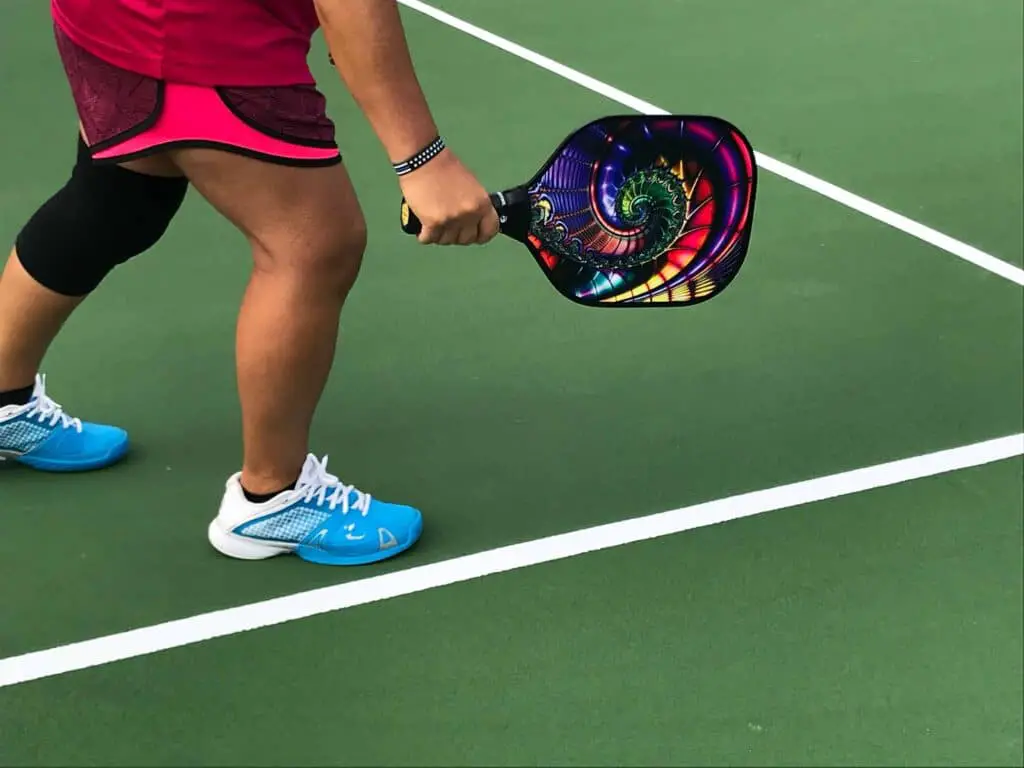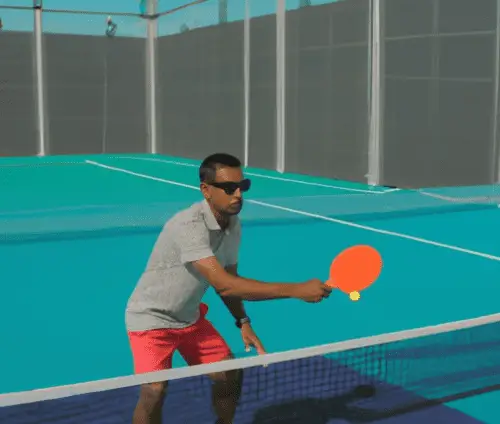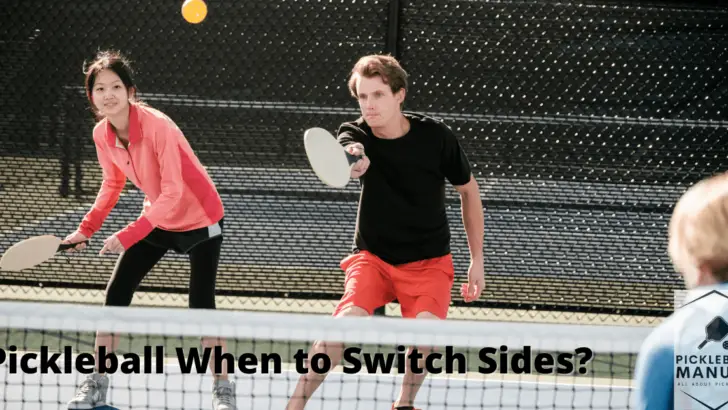Do you wonder about when to switch sides in a pickleball game? I’m going to discuss this in detail in this article. There are various unique rules associated with this game, including switching sides. The question arises: When a pickleball player can switch sides?
Players can switch their sides in a pickleball game after their first game. When the team gets their 6 points, players can switch their sides if there is a need for a third game. Players can also switch their sides during the consolation events in which there is just 1 game comprising of 15 points.
Pickleball is becoming a prevailing game all around the world. Older adults initially preferred it as it is not hard on their joints, but now this game is endorsed by people of all ages. Professional tennis and badminton players also love to play pickleball in their free time as it helps improve their game.
A tournament-based match of pickleball comprises two to three games of 11 points. The game is finished when one of the players or team reaches the 11 points or scores and wins the match by at least two to three points. If the game is tied between both the teams, then one of the players continues the game till they win by two scores. After a third game, players are eligible to switch their sides.
A Brief Introduction to Switching Sides in Pickelball:
Switching is referred to as a variation of stacking in which each player from the team starts to play from their traditional side and then can switch after their serve. Switching is not like stacking which you have to show your hand to the opponents.
It involves the start of the game in a traditional position, after which you can move towards your server. You can quickly signal to your partner and decide either to stay or switch in the game.
You can also fake your opponents through switching. You can confuse your opponents that you will switch but can move back to your original positions after deciding not to switch during the game. In this way, opponents will be confused, and you can play easily.
Switching and stacking are related, but stacking involves the formation in a doubles game in which players from both sides line up to one side of the court during the return of their serve. Each teammate can then move back to their original positions.
Rules and Regulations in Switching in Pickleball:

Both the teams’ partners are well aware of how they will ace the game. The players know that they can win more points while standing on an even side. The other partner is direct across from one of the opponents.
You can implement the stacking strategy to keep up this alignment. Stacking helps attain an extreme and powerful play. Still, it is necessary to follow the rules to participate in this strategy. Some of the main rules for stacking and switching the sides are:
- It is stated that the players should serve the ball from the same side of their gameplay.
- The players are allowed to serve the ball to their same side.
- It is stated in the rules that non-serving players should hit the return of their service, and the correct serving player should hit the ball. It is legal to stack as long as the server follows the original guidelines. It is advisable not to cross the plane of the net.
Combination of Stacking and Switching:
There are many primary reasons why players use stacking as their main strategy and relate it with switching. The main advantage is to strengthen the efforts of their team. Here we will discuss some common combinations, including the following:
| Right-left combination | When one player has a strong forehand, the team’s stack. It is because there are no two backhands in the middle. |
| Advanced teams and mates | This strategy helps the players to poach the balls and provides them with a better reach. |
| Non-athletic partners | Stacking enables the non-professional members of the team to move less around the court and switching is prevented so that game can be played smoothly. |
Advantages of Switching:
| Firepower | Firepower includes the one or both sides of the player as the dominant one and is similar to stacking. It is placed in the middle in case of switching. |
| Confusion | Stacking creates a sense of chaos and confusion for the opponents. They cannot judge whether you will stay in your traditional position or will switch the spots with your partner. |
| Fake switching | You can create confusion between the opponents by faking the switch. It will exacerbate the sense of confusion in the entire game. |
| Aborting the switch | You can abort the switch if the opponent executes a service that can put the return-of-server out of the position. It will not provide them the time for making a switch. |
Disadvantages when Switching:
There are many advantages of switching the sides in a pickleball game. But there are some disadvantages too, so you should play strategically. A player should take extreme care so that the game won’t be ended up in the ‘I’ formation on the courtside.
| Third shot drive | The switching partner obstructs the return of server’s sight while doing a switch. It can make the third shot drive a challenging one from the opponents. |
| Confusion | Players often get confused between switching and stacking. It is advisable not to mess with such a thing as it can lead to a fault. |
| Communication with partner | It is necessary for both the partners to communicate well with each other before switching. Poor communication is critical and can lead the game undefended. |
Hand Signals During Switching:
Hand signals are a form of gestures and mode of communication between the partners in a pickleball game. These signals are used when you will implement the switching strategy in the game. The return-of-server glances at their partner to return the serve.
The partner must be positioned in the non-volley zone and should acknowledge the signal. An open hand means to switch hand signals, and a closed fist means staying in the game. You can also indicate a fake switch for creating confusion for opponents.
Serving and Switching:
- A player or team can score points during serving in a pickleball game. Previously, there was a rule that players cross the baseline with one foot while attempting a serve. But they must keep one foot behind the baseline after contacting the ball. This rule is changed now, and it sets that both feet must be set behind the baseline. You cannot switch sides in between.
- Players should also announce their scores before serving. It is said to call the server’s score on a priority basis, and then comes the opponent’s score.
- The player should try the service with an underhand stroke. The ball should make contact below the waistline.
- The arm should move upward while striking the ball and keep the paddle head below the wrist. The paddle head excludes the handle part of the paddle.
- Make sure to land the serve diagonally between the non-volley zone and baseline of the service court that is on the opposite side of the serving players. It is a short serve that lands on the kitchen line.
- In drop serve, the player drops the ball and keeps it in a bouncing state before the strike. There are no restrictions on the paddle motion in a drop serve.
- Every player is allowed to attempt a single-serve. The gameplay continues if the ball touches the net and lands in the service area.
Points to Remember for Serve and Return Shots:
- Serve made legally should be hit with an underhand motion. No sidearm or overhead shot is allowed, and the player should make contact below their waistline.
- The player should contact the ball before it hits the ground zone.
- The player should make the ball land in their opponent’s court, which is diagonal and opposite the server.
- Place the server feet behind the baseline in the gameplay.
- It is a fault if the ball contacts the non-volley zone line.
- Serves should be dropped over the non-volley zone area or deep in their backcourt.
- Consistency is the key to serving and varies with the height, speed, depth, and angle of the services made in the gameplay.
- A player should play with accuracy rather than attempting a power return.
Also Read:
Is Pickleball Easier Than Tennis? All You Need to Know
Does Pickleball Require Running? All You Need to Know
Frequently Asked Questions (FAQs):
What do you mean by switching in a pickleball game?
Switching is considered a variation of stacking in a pickleball game. In switching, the player from each side plays in their traditional side and then will switch after doing a serve. Switching includes an element of surprise.
Does the server switch their sides after winning a point in a pickleball game?
Until or unless a point scores, the players on the serving team do not alternate their sides. The serve goes to the other team when the second server loses the serve. The player on the right serves first, and receiving side does not alternate the sides.
Can a player serve from the left side in a pickleball game?
If there is no second server in the serving team, single scoring in pickleball is similar to double scoring. The player should serve from the right service court if the score is an even number. If the score is in an odd number, the player can serve from the left service court.
What are the five rules related to a pickleball game?
There are five key rules associated with a pickleball game, including:
- The ball should stay in bounds.
- There must be one bounce per side.
- The serving must be done at the baseline.
- You cannot land the serve in the no-volley zone.
- The Pickleball game ends at 11, 15, or 21 points.
Is it allowed to hit the ball on the partner’s side in the pickleball game?
The serve is replayed as a let when it hits the partner of the person who receives the serve before touching the court’s surface. The point is given to the team whose serve hots the opponents before bouncing.
Is it compulsory for the service to be underhand in the pickleball game?
It is said by the international pickleball rules that services must be made underhand. The contact of the paddle should be below the navel level of the server. After the ball is struck, the foot should not contact the baseline or the court.
Does the receiving team score points in the pickleball game?
The score is given to the receiving team, and they gain a service if they win a rally. The rest periods in the match should not be longer than two minutes.
Can a player return a serve in the pickleball game?
It is a fault if a player does not return the serve in the pickleball game. The receiver should let the bounce once on the side before returning the ball.
Does the return serve land in the kitchen in a pickleball game?
It is recommended that service should never land in the kitchen, called a non-volley zone. It is an automatic fault if it hits the net beforehand, and you will lose your serve.
Which shot is considered the most aggressive one in the entire pickleball game?
The most aggressive shot in a pickleball game is the overhead smash. It is a forceful hit that executes in the air. The player can reach the shot and direct it downwards at an angle to the opponent’s court. It is impossible to defend a well-executed smash.
What do you mean by DUPR in a pickleball game?
DUPR stands for Dreamland Universal player rating and is an official rating system of PPA (Pro Pickleball Association).
Explain the rules for stacking in a pickleball game?
When player A receives serve from the even side, and player B receives the serve from the odd side of the court, the stacking is only necessary at such point. The non-receiving partners can stand near their net as they do not need to wait for their next shot to bounce.
How can you become a 4.0 Pickleball player?
4.0 Pickleball is a skill level in which the player is more consistent in all phases. The player should focus on mastering their forehand and backhand shots. They should be able to attack their opponents directly and aggressively.

I am Suryashankar, a passionate pickleball player with over 3 years of experience. I created this website to share my knowledge and experience with others just starting or looking to improve their game.
My mission is to provide you with the most unbiased and comprehensive information about pickleball.
Through my experience and expertise, I have curated this article to offer valuable insights, tips, and tricks to help you become a better player.


